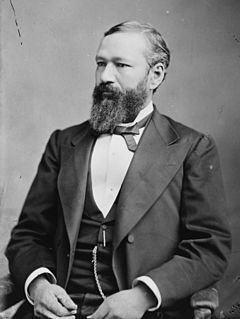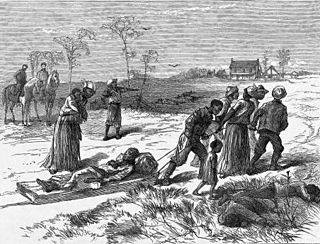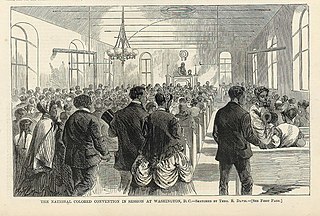Related Research Articles

Pinckney Benton Stewart Pinchback was an American publisher, politician, and Union Army officer. Pinchback was the first African American to serve as governor of a U.S. state and the second African American to serve as lieutenant governor of a U.S. state. A Republican, Pinchback served as acting governor of Louisiana from December 9, 1872, to January 13, 1873. He was one of the most prominent African-American officeholders during the Reconstruction Era.

In the history of the United States, carpetbagger is a largely historical term used by Southerners to describe opportunistic Northerners who came to the Southern states after the American Civil War, who were perceived to be exploiting the local populace for their own financial, political, and/or social gain. The term broadly included both individuals who sought to promote Republican politics and individuals who saw business and political opportunities because of the chaotic state of the local economies following the war. In practice, the term carpetbagger was often applied to any Northerners who were present in the South during the Reconstruction Era (1865–1877). The term is closely associated with "scalawag", a similarly pejorative word used to describe native white Southerners who supported the Republican Party-led Reconstruction.

The Colfax massacre, sometimes referred to by the euphemism Colfax riot, occurred on Easter Sunday, April 13, 1873, in Colfax, Louisiana, the parish seat of Grant Parish. An estimated 62–153 black militia men were murdered while surrendering to a mob of former Confederate soldiers and members of the Ku Klux Klan. Three white men also died in the confrontation.

More than 1,500 African American officeholders served during the Reconstruction era (1865–1877) after passage of the Reconstruction Acts in 1867 and 1868 as well as in the years after Reconstruction before white supremacy, disenfranchisement, and the Democratic Party fully reasserted control in Southern states. Historian Canter Brown, Jr. noted that in some states, such as Florida, the highest number of African Americans were elected or appointed to offices after 1877 and the end of Reconstruction. The following is a partial list some of the most notable of the officeholders pre–1900.
Alexandre Etienne de Clouet, also known as Alexandre Etienne de Clouet, Sr., was an American politician and sugar planter who was active in Louisiana politics both before and after the Civil War. During Reconstruction, he violently opposed Black suffrage, becoming a leader of the violent White League that attacked freedmen who attempted to vote.

George Thompson Ruby (1841-1882) was a prominent black Republican leader in Reconstruction-era Texas. Born in New York and raised in Portland, Maine, he worked in Boston and Haiti before starting teaching in New Orleans, Louisiana before the end of the American Civil War.

The Colored Conventions Movement, or Black Conventions Movement, was a series of national, regional, and state conventions held irregularly during the decades preceding and following the American Civil War. The delegates who attended these conventions consisted of both free and formerly enslaved African Americans including religious leaders, businessmen, politicians, writers, publishers, editors, and abolitionists. The conventions provided "an organizational structure through which black men could maintain a distinct black leadership and pursue black abolitionist goals." Colored Conventions occurred in thirty-one states across the US and in Ontario, Canada. The movement involved more than five thousand delegates.

James T. White was a Baptist minister and state legislator from Helena and Little Rock, Arkansas. He was a member of the Arkansas House of Representatives and later the Arkansas Senate in the late 1860s and early 1870s. He was also a member of the Arkansas constitutional conventions in 1868 and 1874. He edited the Baptist newspaper, The Arkansas Review. He was an African-American and a Republican. In 1868 he was among the first six African Americans to serve in the Arkansas House.
Ulysses L. Houston was a pastor and state legislator in Georgia. He was elected to the Georgia State Legislature in 1868, and was an influential organizer in Savannah, Georgia's African-American community during the mid-19th century.

Henry Demas (1848–1900) was an enslaved African American who became a constable, state legislator, civil rights activist, and organizer of Southern University in Louisiana during the Reconstruction era.
William "Beverly" Nash was a barber, shoe shine, porter, waiter, and state senator in South Carolina. An African American, Nash was born enslaved in Virginia, Nash gained his freedom at the age of 43 with the passage of the 13th Amendment. After the Civil War he became a state legislator during the Reconstruction Era. He was instrumental in drafting South Carolina's Constitution of 1868, and held several committee positions in the state government over his career. He held his office for 21 years before resigning.
Thaddeus Kenlock Sasportas was a state legislator in South Carolina during the Reconstruction era. He represented Chester County, South Carolina in the South Carolina House of Representatives. A document describes him as a slave before the American Civil War, as being a Baptist minister, and as Black.
James Henri Burch, often written as J. Henri Burch, was an African American state legislator in Louisiana during Reconstruction, the years after the Civil War. He represented East Baton Rouge Parish in both the state's House of Representatives and Senate and was an important Black political leader in the period.
William Murrell was a minister in the African Methodist Episcopal (A.M.E.) church and a state legislator in Louisiana. He was born into slavery and was the son of his mother's owner. His ownership was transferred and he was sold on several occasions. He helped establish several churches. He served several terms during the Reconstruction era representing Lafourche in the Louisiana House of Representatives.
Harry Lott was an African American Republican politician in Louisiana during Reconstruction. He was elected to the Louisiana House of Representatives, representing Rapides Parish, 1868 and 1870.
James H. Washington was a school principal and state legislator in Texas.

Jeremiah M. P. Williams was a Baptist preacher and state legislator in Mississippi. He served several terms in the Mississippi Senate during and after the Reconstruction era. He represented Adams County, Mississippi.
John D. Webster was a state legislator, government official, and lawyer in Mississippi. He was born in Virginia and arrived in Mississippi in 1869. He was appointed a clerk of the Washington County, Mississippi circuit court in 1871 and was a member of the Mississippi House of Representatives in 1872 and 1873. He was a candidate for Louisiana Superintendent of Education but lost the Republican nomination to Thomas W. Cardozo. He studied law and was admitted to the Mississippi bar in the late 1870s. During the American Civil War he served in the 54th Massachusetts regiment and was a "quarter-master sergeant". He was one of Mississippi's attendees at an 1872 Colored Convention.
George Young Kelso was an American politician. He was delegate at Louisiana’s 1868 constitutional convention and state senator in Louisiana from 1868 to 1876. He was a “colored”, “radical” Republican.
Joseph Connaughton was a state legislator in Louisiana. He was elected to two terms. He only served part of his second term in the Louisiana House of Representatives. He was African American.
References
- ↑ Hogue, James K. (November 15, 2011). Uncivil War: Five New Orleans Street Battles and the Rise and Fall of Radical Reconstruction. LSU Press. ISBN 9780807143926 – via Google Books.
- ↑ Horne, William. "Perspective | The true danger of Trump and his media allies denying the election results" – via www.washingtonpost.com.
- ↑ "State Colored Men's Convention". n/a. July 6, 1873.
- ↑ Black Legislators in Louisiana during Reconstruction by Charles Vincent
This article needs additional or more specific categories .(July 2021) |